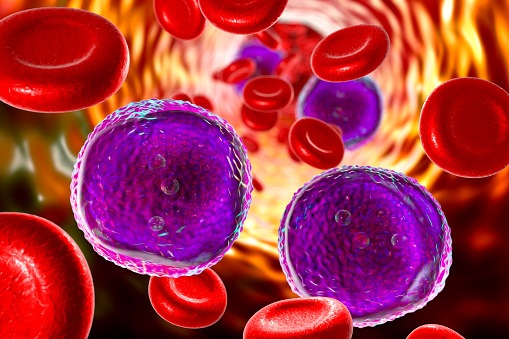
Leukemia, which derives from the Greek words leukos (white) and haima (blood) is a form of cancer that affects the blood and bone marrow and occurs when the body experiences an overproduction of white blood cells. Leukemia results from a mutation in the single DNA of a single cell which alters that cell’s ability to develop and function. This year alone in the US, 61,780 people are expected to receive a leukemia diagnosis, and there are almost 400,000 people living with or in remission from this disease. Overall, 22,840 people are expected to die from leukemia in 2019, and from 2011-2015, leukemia was sixth most common cause of death among cancers in both men and women.
Types of Leukemia
It’s important to note that there are many types of leukemia, which are classified by the white blood cell involved. The main forms of leukemia are myelogenous and lymphocytic, and each of these has both an acute, and a chronic form. Acute leukemia grows quickly, and affects immature cells, preventing them from working properly, while chronic leukemia develops more slowly, allowing the body time to fight subsequent infections.
The four main types of leukemia are:
Acute lymphocytic leukemia (ALL)
This form of leukemia occurs predominantly in children, and approximately 6,000 new cases are diagnosed annually. ALL carries a five-year survival rate of 68.2%.
Chronic myelogenous leukemia (CML)
CML mainly affects adults, and about 9,000 new cases are diagnosed each year. This form of leukemia has a five-year survival rate of 66.9%.
Chronic lymphocytic leukemia (CLL)
This form of leukemia manly effects older people (over the age of 55) with approximately 20,000 new cases diagnosed each year, and has a favorably five-year survival rate of 83.2%.
Hairy cell leukemia
A rare subtype of CLL.
Symptoms
Anemia: Because leukemia patients produce a lower number of red blood cells, they may suffer from anemia, which slows the delivery of oxygen to the body’s muscles and organs. People with anemia generally have low energy, and may experience increased fatigue, and a pale complexion.
Increased bruising and bleeding: Leukemia patients may bleed from their gums or noses or might find blood in their stool or urine. Also, they may bruise very easily, and from minor bumps. People with leukemia may have small spots of discoloration — called petechiae — under their skin.
Susceptibility to infections: The disease affects the body’s immune system, therefore leukemia patients are vulnerable to infections, such as a sore throat or bronchial pneumonia which may be accompanied with headache, low-grade fever, mouth sores or skin rash.
Enlarged lymph nodes: Leukemia causes an abnormal production of lymphocytes which result in enlarged lymph nodes lymph node in the throat, armpits or groin.
Bone and joint pain: Sometimes leukemia cells grow near the surface of the bone or inside the joint, which can lead to bone or joint pain.
Abdominal swelling: Leukemia cells may accumulate up in the liver and spleen, making them larger. You may noticed a fullness or swelling of the belly or feeling full after consuming a small amount of food.
General health decline: Additional symptoms of leukemia include decreased appetite, weight loss, and discomfort under the left lower ribs. Moreover, many people with leukemia experience night sweats.
While any of these symptoms might point to a condition less serious than leukemia, if you experience several of these symptoms in combination, it’s best to schedule an appointment with your physician, who may refer you to a hematologist for further testing.







 © 2025 Mashup Media, LLC, a Formedics Property. All Rights Reserved.
© 2025 Mashup Media, LLC, a Formedics Property. All Rights Reserved.